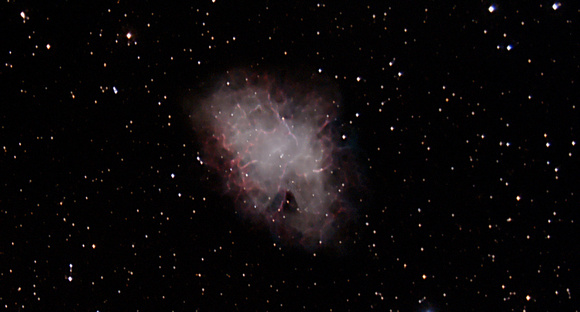Crab Nebula M1
28 x 360sec ISO1600 Darks and Flats applied.
Beautiful and Cold Night Temp 18 degrees
Developed in PS_CS3, Image Plus and Noise Ninja
Canon Rebel XTi (400DH) spectrum enhanced camera with built-in astronomical UV/IR blocking filter (Type Ib) )
Primary Scope Celestron 1100 CGE with 6.3 Rerducer
Guiding with Meade 80ED (.8 Reducer)
Guiding PhD
DATA:
First observed in 1731 by John Bevis, the Crab Nebula corresponds to the bright SN 1054 supernova that was recorded by Chinese and Arab astronomers in 1054 CE. The nebula was independently rediscovered in 1758 by Charles Messier as he was observing a bright comet. Messier catalogued it as the first entry in his catalogue of comet-like objects. The Earl of Rosse observed the nebula at Birr Castle in the 1840s, and referred to the object as the Crab Nebula because a drawing he made of it looked like a crab.[5 The star that exploded as a supernova is referred to as the supernova's progenitor star. Two types of stars explode as supernovae: white dwarfs and massive stars. In the so-called Type Ia supernovae, gases falling onto a white dwarf raise its mass until it nears a critical level, the Chandrasekhar limit, resulting in an explosion; in Type Ib/c and Type II supernovae, the progenitor star is a massive star which runs out of fuel to power its nuclear fusion reactions and collapses in on itself, reaching such phenomenal temperatures that it explodes. The presence of a pulsar in the Crab means that it must have formed in a core-collapse supernova; Type Ia supernovae do not produce pulsars


